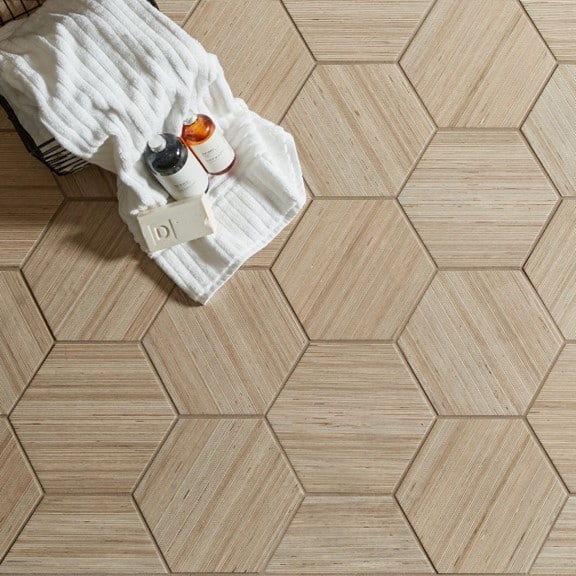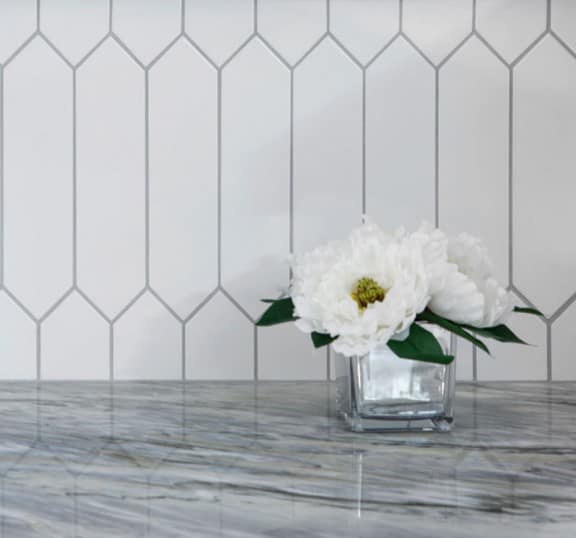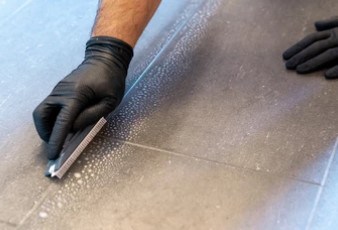
Featured Image: Shibusa Crema Hex 9 x 11 Porcelain Floor Tile from Arizona Tile
An important part of your tile and stone maintenance is taking care of the grout – However, it can be difficult to know exactly what it is, how to care for it, and how often it needs touching up. There is no need to stress about this process taking all weekend, a bit of knowledge and regular maintenance will keep your tile and grout beautiful. Here is a basic overview of how to keep your surfaces looking their best.
What is Grout?
Grout is a paste-like material used for filling gaps, like those between tile. It comes in a variety of colors, allowing you to coordinate it with your tile or choose a contrasting shade. There are two main types of grout, both of which are used in residential tile-laying: sanded and unsanded.
Sanded Grout
Sanded grout has finely-ground sand mixed into it, which creates a thicker paste As it dries, the sand is suspended throughout, which helps fight shrinkage and keeps your tile in place. This type of grout is best for hardier applications, like flooring that has a 1/8” or wider grout joint, as it won’t shrink from the edges over time. For those using extra-wide tile joints of ½” or larger, you will want to use wide-joint mixture which is even more resistant to shrinking, as it has a higher volume of sand.

Image: Paloma Cotton Glossy Picket 3 x 12 Ceramic Kitchen Backsplash Tile from Arizona Tile
Unsanded Grout
This thinner material is made of all the same basic components as sanded grout, just without the sand additive. It’s ideal for tile with small joints, as it is thin enough to be piped or laid into very narrow gaps. The consistency also allows for more precise laying. Vertical tile applications, like backsplashes, are best suited for unsanded grout. Even over large surfaces, it’s easier to spread out precisely and create a stable backdrop for tile to cling to.
How Grout Gets Dirty
Ultimately, environment is the biggest factor in how quickly grout gets dirty. High-traffic areas will likely accumulate dirt or dust faster than lower-traffic areas and may need cleaning more often. Grout in wet environments, like showers, will likely also get dirtier or spotted faster. While it is true that sanded grout’s texture may attract or hold more dirt and dust, that alone is not a great predictor of how often it will need to be cleaned. Also, both sanded and unsanded grout should be sealed with a penetrating sealer to help prevent staining. Once done, this will help make cleaning and maintenance
Color is also a factor when considering how grout gets dirty. While the different shades do not affect the rate at which dirt and dust accumulates, it does impact how visible it is. Lighter shades may show dirt sooner and more obviously than darker grouts.

Image: Cleaning Floor Tile Grout
The Best Way to Clean Grout
To get your grout truly clean, the surrounding tile needs to be free of dust or dirt first. Lightly dampen a cloth with your usual tile cleaner and wipe down all nearby surfaces. Without this step, any lingering dirt on the tile can be pushed back onto the grout as you clean it.
Porcelain and Ceramic Tile
A lighter solution will work for basic upkeep, but for a deeper clean, apply a tile degreaser with a mop, sponge or spray bottle. Be sure to thoroughly coat all visible grout with your cleaner. When cleaning ceramic and porcelain tile, you can use an acidic-based cleaner to clean soap scum and mildew. Giving your cleaning solution time to soak into the grout enables it to pull out more dirt and stains. Allow it to sit for 5-10 minutes prior to scrubbing. Next, scrub all visible grout with a medium bristled brush. Once you have completely cleaned your grout, rinse with clean water and dry.
Stone Tile and Slab
For stone, only use natural stone cleaners that are non-acidic. For cleaning soap scum and mildew on stone, only use shower stone cleaners. Lightly brush grouts with soft to medium brush. Then rinse and dry. Reseal stone every year.
At Arizona Tile, our team is here to help with all things tile. Feel free to contact us today if you have any questions about the care of the grout or tile in your home. With our experience and knowledge, we’ll guide you through the maintenance steps recommended for your space.
If you’re ready to lay new tile in your home, we also have online design tools to aid you in redesigning your space. Our Just Imagine Visualizer lets you see how a tile will look in your home before committing, and the Online Slab Yard lets you find the piece you need.





